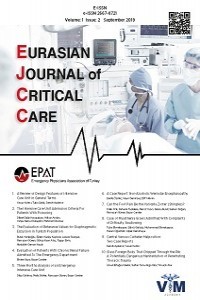A CASE REPORT: HERPES ZOSTER WITH SACRAL INVOLVEMENT
A CASE REPORT: HERPES ZOSTER WITH SACRAL INVOLVEMENT
Sacral pain, varicella zoster,
___
- 1- Azap A, Kurt H. Varisella Zoster virüs infeksiyon¬ları, Ankara Üniversitesi Tıp Fakültesi Mecmuası 2001;54(4):357-70.
- 2- Cohen JI, Brunell PA, Straus SE, Krause PR. Recent advances in varicella zoster virüs infection, AnnInternMed1999;130(11):922-32. http://dx.doi.org/10.7326/0003-4819-130-11-199906010-00017 PMid:10375341
- 3- Dworkin RH, Johnson RW, Breuer J et al. Recommendations for the management of herpes zoster, ClinInfectDis2007;44(Suppl 1):S1-26. http://dx.doi.org/10.1086/510206 PMid:17143845
- 4- Insinga RP, Itzler RF, Pellissier JM, Saddier P, Nikas AA. The incidence of herpes zoster in a United States administrative database, J Gen Intern Med2005;20(8):748-53. http://dx.doi.org/10.1111/j.1525-1497.2005.0150.x PMid:16050886 PMCid:PMC1490195
- 5- Schmader K. Herpes zoster in older adults, ClinInfectDis2001;32(10):1481-6. http://dx.doi.org/10.1086/320169 PMid:11317250
- 6- Kurlan JG, Connelly BL, Lucky AW. Herpes zoster in the first year of life following postnatal exposureto varicella-zostervirus: four case reports and a review of infantile herpes zoster. ArchDermatol2004;140:1268-72. http://dx.doi.org/10.1001/archderm.140.10.1268
- 7- Henry M, Feeder J, Diane M. Herpes zoster in other ¬wise healthy children. Pediatr Infect Dis J 2004;23: 451-7. http://dx.doi.org/10.1097/01.inf.0000126901.88982.32
- 8- Sterling JC, Kurtz JB. Viral infections. In: Champion RH, Burton JL, Burns DA, Breathnach SM: Textbook of Dermatology. Vol 2. Oxford: Blackwell Science, 1998:995-1097.
- 9- Arvin AM: Varicella-zostervirus. Clin Microbiol Rev 1996;9:361-81.
- 10- Chang CM, Woo E, Yu YL, Huang CY, Chin D: Herpes zoster and its neurological complications. Postgrad Med J 1987;63:85-9.
- 11- Yavaşoğlu İ, Arslan E, Gök M, Kurna R. Erişkin zona: olgu serisi ve derleme, Uludağ Üniversitesi Tıp Fakültesi Derg2008;34(3):123-5.
- Başlangıç: 2019
- Yayıncı: Acil Tıp Uzmanları Derneği
A CASE REPORT: HERPES ZOSTER WITH SACRAL INVOLVEMENT
Muhammed EKMEKYAPAR, Tuba EKMEKYAPAR, Hakan OĞUZTÜRK, Şükrü GÜRBÜZ, Hasan GÖKÇE
Hasan GÖKÇE, Mehmet Ediz SARIHAN, Muhammed EKMEKYAPAR
Serkan DOĞAN, Utku Murat KALAFAT, Rabia Birsen TAPKAN, Ramiz YAZICI, Bensu BULUT, Büşra BİLDİK, Doğaç Niyazi ÖZÜÇELİK, Basar CANDER
Evaluation of low back pain prevalence in emergency department workers
Dilek ATİK, Basar CANDER, Cesareddin DİKMETAŞ, Bensu BULUT, Emre GÖKÇEN, İbrahim ÇALTEKİN, Levent ALBAYRAK, Hasan KAYA
A Case of Suicide by Hara-Kiri in Turkey
Hüseyin METİN, Begüm SAKIN, Bahadir TASLİDERE, Bedia GÜLEN, Ertan SÖNMEZ
PREDICTORS OF EARLY AND LATE MORTALITY IN MULTITRAUMA PATIENTS
Burcu YAVUZ, Mehmet ERDOĞAN, Şahin ÇOLAK
Thyrotoxic Hypokalemic Periodic Paralysis: Case Report
Utku KALAFAT, Busra BILDIK, Gulcan CAGLAR, Serkan DOGAN, Basar CANDER
Tuba EKMEKYAPAR, Muhammed EKMEKYAPAR, Şükrü GÜRBÜZ, Hakan OĞUZTÜRK
Management of a Patient With a Single Coronary Artery Anomaly During a Heart Attack
Evaluation of fatal trauma cases presented to the emergency room
Abdullah ALGIN, Ertuğrul ALTINBİLEK, Ahmet Burak ERDEM, Miray TÜMER
